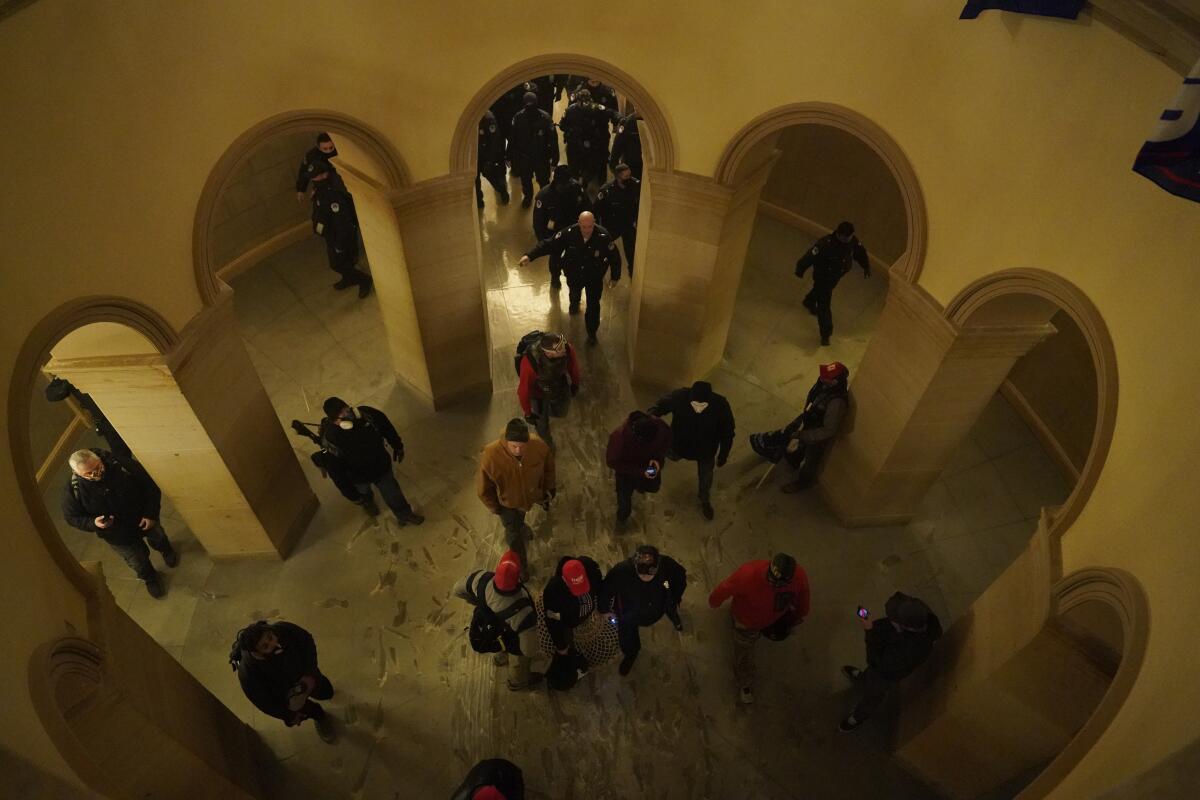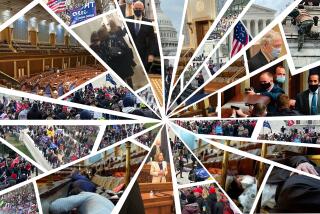Column: Did the Capitol mob have inside help? If so, can a simple majority vote send the insiders packing?

Suspicions have been mounting that the insurrectionist mob that stormed the Capitol on Jan. 6 may have had inside help, possibly from staff or members of Congress. Thirty Democratic representatives have asked for an investigation of what looked to some like tour groups being guided through the halls Jan. 5, even though the Capitol is closed to the public because of COVID-19.
Perhaps most chillingly, Rep. James E. Clyburn (D-S.C.), the majority whip, told CNN that the interlopers flew past his official, well-marked office off Statuary Hall but pounded on the door and shouted outside his unmarked private rooms, which even Congress members often can’t find in the Capitol maze.
None of this amounts to proof; it demands investigation. To that end, Rep. Cori Bush (D-Mo.) has called for the House Ethics Committee to look at whether any members who had sought to overturn Joe Biden’s election violated their oaths of office and “should face sanction, including removal from the House of Representatives.”
Bush’s resolution invokes Section 3 of the 14th Amendment, which provides that no one can hold a wide variety of state and federal military, executive and legislative jobs, including senator or representative, if they have taken an oath to the Constitution and then engaged in insurrection against the United States.
The citation of Section 3 is purposeful. The Constitution allows the House to expel any representative, for pretty much any reason, as long as a supermajority — two-thirds of the members — agrees. The 14th Amendment, on the other hand, can be used to banish members with a much easier to obtain simple majority.
In the current House, Democrats would need to persuade nearly 70 Republicans to join them in a vote to expel, but they would need no GOP help to use the banishment powers of Section 3.
What are those powers?
The 14th Amendment, passed in the wake of the Civil War, is the cornerstone of protections against unconstitutional conduct by the states; it is the source, for example, of the guarantee of due process and equal protection under the law. Section 3 of the amendment has been used sparingly in modern times, but it was a big deal in the 1860s when Congress deployed it to keep former rebels from serving in the military and in Congress.
Missing from much of the current commentary about Section 3 is this crucial point: It adds a qualification to the short list of prerequisites for public office already in the Constitution. (For example, a House member must be at least 25 years old, and senators and representatives must reside in their districts.) Each house, according to Article I, Section 5, acts as judge of whether its members meet the constitutional qualifications, determined by a majority vote. Any representative who is disqualified in such a vote is refused a seat, in a process called exclusion.
The qualification/exclusion aspect of Section 3 means that it can’t allow for a simple majority vote to remove members in Congress today, no matter what the Ethics Committee turns up. All the members of the 117th Congress were sworn in and seated Jan. 3. It’s no longer possible to exclude any of them from Congress; they would have to be expelled. Which takes Democrats back to the pesky need for a two-thirds, supermajority vote.
Congress last invoked Section 3 in 1919, in the hyperpatriotic and paranoid days after World War 1. It’s a remarkable exclusion story.
Victor Berger, a founding member of the Socialist Party of America, was elected in 1918 for a second term to the House from Milwaukee. Congress refused to seat him on the grounds that his writings and speeches were disloyal to the war effort and that he was not qualified to serve under Section 3. (Berger was under indictment for and would later be found guilty of violating the Espionage Act; the Supreme Court wound up overturning his conviction.) A special election was held to replace Berger. He ran again and won. Again the House excluded him, and with much of his two-year term consumed, the seat remained vacant until the next election in 1920. Berger, once cleared of the Espionage Act charge, went on to represent Wisconsin three more times in the House.
Section 3 isn’t going to provide a quick, easy method of removal if members of Congress are found to have been complicit in the attack on the Capitol. But in a more protracted way, it may be of use for House Democrats against “coup crew” Republicans.
Based on evidence turned up by the House Ethics Committee investigation, the House could by a simple majority vote determine that some members fall on the wrong side of Section 3. That wouldn’t send those representatives packing, but it would allow citizens in their home states to sue to keep them off the 2022 ballot should they try to run again — just as if they were, say, underage. Alternatively, if any were to win reelection in 2022, the House could then exclude them, again with a simple majority vote.
If facts bear out that elected representatives conspired in the assault on the Capitol, two-thirds of the House should do the right thing and expel them. However, if the sharply divided House can’t muster the necessary supermajority, Democrats can fall back on Section 3. It won’t banish the conspirators in 2021, but it could make this term their last.
@HarryLitman
More to Read
A cure for the common opinion
Get thought-provoking perspectives with our weekly newsletter.
You may occasionally receive promotional content from the Los Angeles Times.










